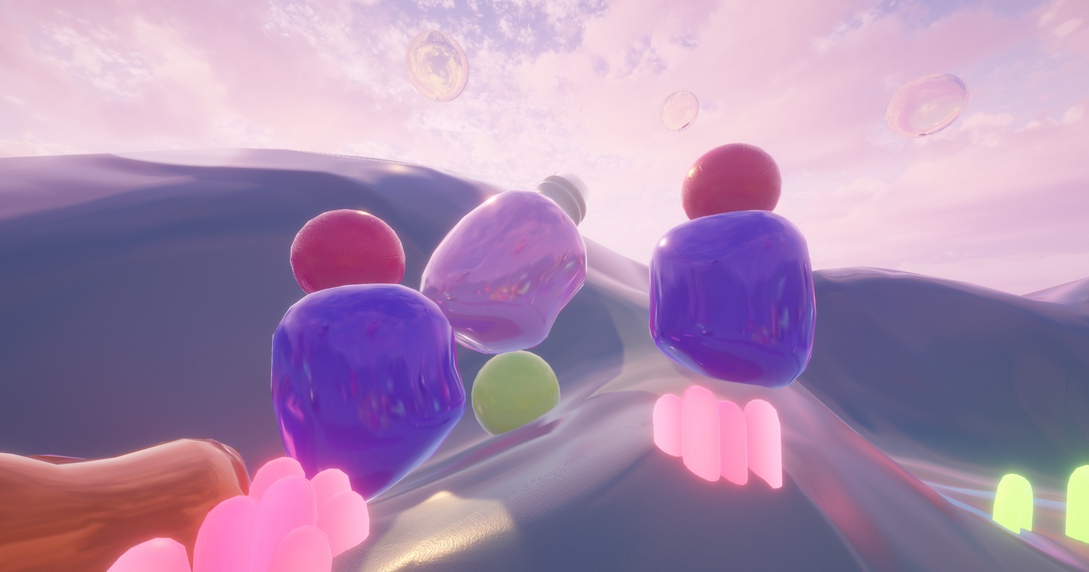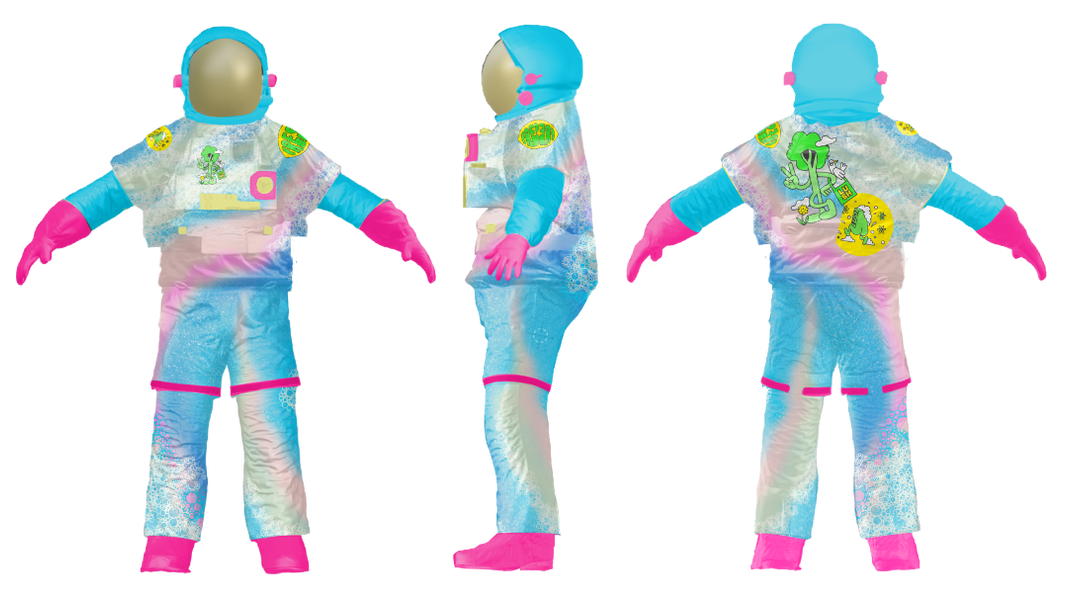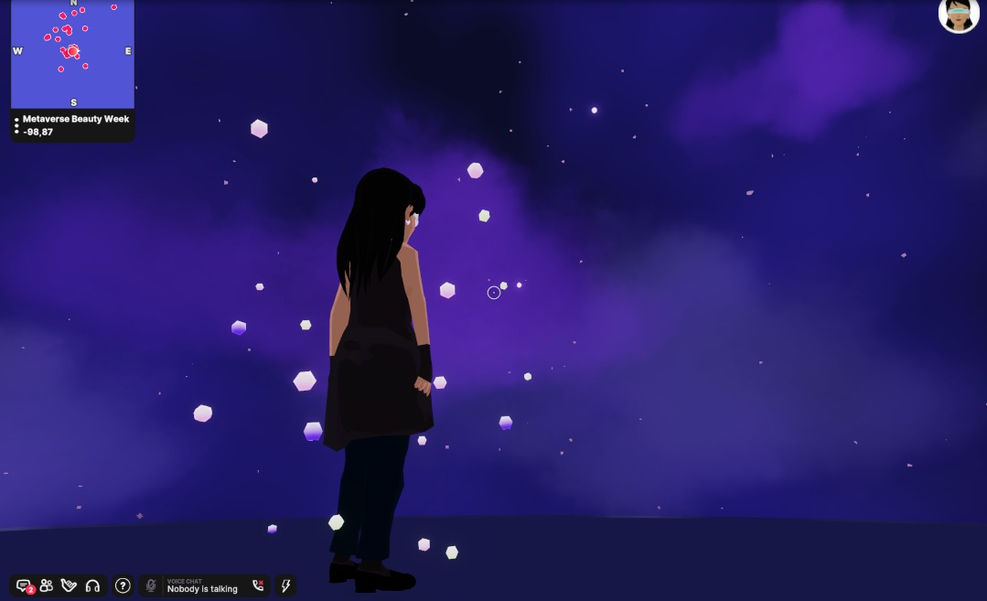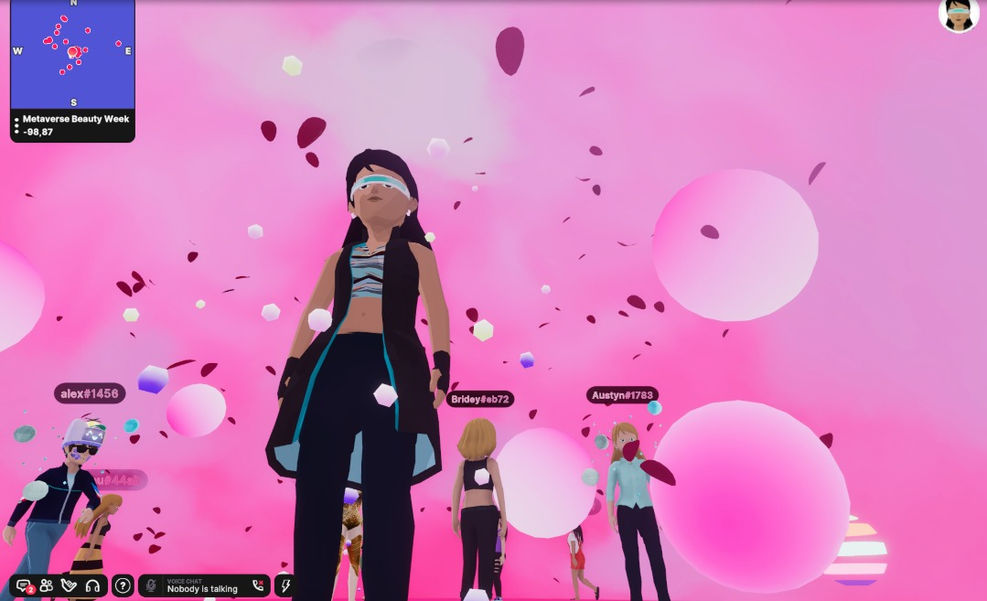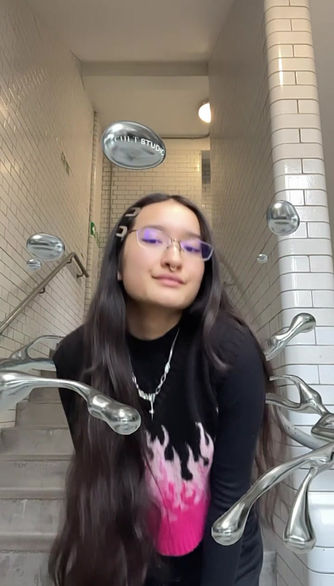
VR & AR projects
Cult - Woven Narratives
I was commissioned by Cult Creative Agency to create a geo-located London themed AR activation and animation in partnership with The WeAR for London Fashion Week and Cult ICONS event sponsored by RED-EYE and Lu.By.Lu at Shoreditch Arts Club.
Co-created with Creative Technologist Katya Pavlenko, “Woven Narratives” is an immersive digital tribute to the city where everyone takes centre stage, influenced from the rich tapestry of culture, heritage and philosophy of London’s international creative scene. The artwork showcases London’s timeless influence on Fashion, through a multi-cultural, Vietnamese-Czech-Ukrainian-British lens.
In honour of London Fashion Week, I sculpted abstract cloth structures with hand drawn textures inspired by Vietnamese, Czech, Ukranian and British textiles and patterns. The AR activation shows these colourful shapes coming into space - London - from all kinds of direction until woven together into a humanoid character making London alive. Inside the gallery, I created a bespoke animation of this Humanoid walking into space and then dissolving back into the separate pieces dynamically flying out of the screen creating a 360 immersive experience marrying the activation outside Shoreditch Arts Club and the inside of the event space.
Metaverse beauty world SUMMIT
To commemorate the inaugural Metaverse Beauty Week in 2023, Metaverse Beauty World hosted a three-day virtual summit hosted across Spatial, Instagram and LinkedIn filled with insightful and inspiring live events, masterclasses and more from thought leaders, creators and brands from the beauty, fashion and tech industry.
My role
I was in charge of concepting, worldbuilding and developing the refreshed Plaza in Unity in line with our Summit brand identity while keeping a reminiscence to Metaverse Beauty Week. Linking back to our iconic MBWeek virtual ambassador NYA, I designed a roundtable space and portal inspired by her mouth and to welcome our guest brands such as Kiki World, Monari Skin and The Future in Black, I designed personalised brand zones to showcase their work.
Metaverse beauty world
Following the success of Metaverse Beauty Week 2023, the Spatial space evolved into the Metaverse Beauty World Plaza which hosts virtual events and panel talks.
My role
I was appointed Creative Owner and was in charge of concepting, worldbuilding and developing the new Plaza in Unity in line with our new brand identity while keeping the reminiscence of Metaverse Beauty Week.
My concept was to break down “Beauty” to its cellular level and embody the “imperfections” of the organic. I wanted to be different from other beauty web3 spaces so instead of your usual life size lipstick floating in space between pink palms, I merged the abstract with beauty products creating geological formations and organisms which seamlessly populate the world.
Metaverse beauty wEEK #mbw2023

The first annual Metaverse Beauty Week, a multi-brand, multi-day festival that re-imagined the way we experience beauty was hosted by CULT. With CULT's code REALITY GETS A MAKEOVER, we explored the future of beauty through the medium of our digital lives in DECENTRALAND, SPATIAL AND ROBLOX.
AWARDS
-
Beauty Matter NEXT 2023 Awards: Best Metaverse Activation
-
The People’s Lovie Awards: Best Web3 & XR Conference, Festival or Party
My role
As a Creative Designer at Cult together with the creative team, I worked on MBW's social content, created the 3D hair textured logo which featured in MBW's moodfilm in collaboration with Serwah Attafuah that screened on the Flannels building in Oxford Street and helped concept and build various brand experiences such as Lush's "Metaverse's Biggest Bath Bomb" and Neutrogena's "Boost your vitals™" and many more.
Rei carter and the forgotten universe
This project aims to show the importance of dreams for our wellbeing by exploring various interactive and immersive media challenging the boundaries of sequential storytelling. In the current context of social media and the Algorithm age, our individuality is increasingly at risk as we are dissociating from the unconscious. Dreams can help us learn more about ourselves, taking Carl G Jung's individuation process as an example.
The story of Rei Carter’s individuation process is told through her instagram profile and is accompanied by an interactive 360 panorama VR experience allowing the audience to plunge into Rei’s subconscious dream worlds and travel through the Forgotten Universe, a realm of collective dream worlds populated by surreal entities and archetypes inspired by Jung’s collective unconscious and indigenous dream theories on dream realms.
The story is set in a parallel universe called Earth-333, where a conforming society uses a dreaming device called i.R.E.M. to enter the lucid dreaming state as entertainment during sleep. This device allows people to create their fantasy worlds, but often artificial and superficial instead of exploring their true inner worlds. One day, Rei Carter's device breaks and opens the access to the Forgotten Universe. Along her journey she rediscovers her true self, but the journey is full of challenges and emotional turmoil as she, for the first time, confronts these unknown sides of her psyche which makes her question her whole "masked" identity.
The Forgotten Universe 360 experience (VR compatible)
Follow Rei's journey
Cult Studio IG AR Filter

Basketball Jam sesh - Spatial build
Hip Hop in da house! In celebration of Hip Hop's 50th anniversary, Spatial hosted a creator's challenge inviting them to create a custom space and avatars using their Creators Tool Kit in Unity.
I wanted to bring Old School Hip Hop into my fictional alternative Universe Earth-X83 by creating a Jam session in a basketball court with custom NPC's that can be interacted with for a virtual dance-off.

Self-care factory
Self-Care Factory explores the theme of love by focusing on the concept of self-love and self-care, the practice of consciously doing things to improve our wellbeing. The character is receiving skin-care and objects connoting self-care activities such as reading, listening to music, exercising and relaxing with a cup of tea next to a scented candle. As the audience scans the image with Artivive, an animation is triggered showing the result of self-care as love circulating and flowers blooming from their head symbolising mental and physical growth.
By putting the theme of self-care in a somewhat contradictory setting of a factory with the character resembling more of a robot, this piece ironically comments on the fact that self-care is not something that can be automated, but is something that needs conscious effort and self-awareness and invites the audience to reflect of their own act of self-care.


AR Hackathon: Hack Your Reality
organised by Ricebox
How to use AR to make a better world?
This hackathon focused on developing an AR prototype in teams by focusing on storytelling and activism.
Our team decided to tackle cultural appropriation in pop culture taking singer Kacey Musgraves inappropriate appropriation of the Vietnamese Ao Dai as an example.
Our vision is for people to stop blindly use other cultures without knowing its context and history, but to represent them with appreciation and accuracy.
Our mission was to use AR to help people learn about the correct context of cultural pieces by developing a filter that points out the cultural appropriation and upon interaction reveals the appropriate context. In this example, as the user scans Kacey Musgraves' photo, the filter shows the correct way of wearing the "ao dai" alongside informative captions about its historical and cultural context.
My role was to 3D model the character and to put it together in SparkAR. The model spins around showing the ao dai and upon tapping the screen, the model changes into different types of ao dai, educating the audience on the historical context of ao dai.






















